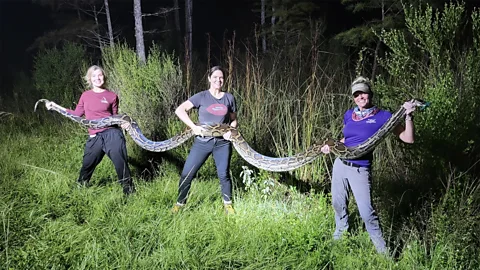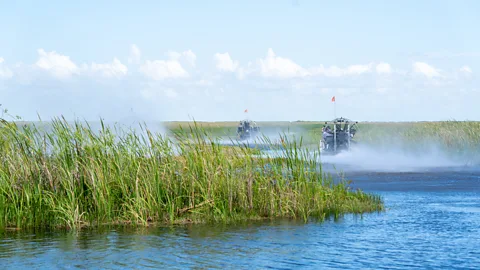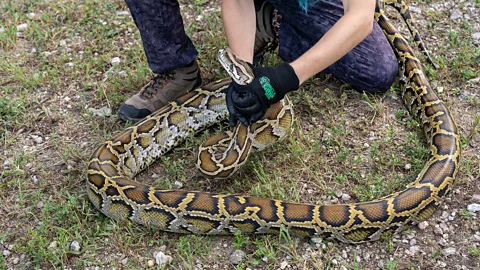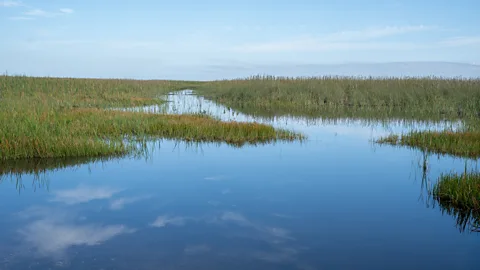Florida is paying bounty hunters to control its python population
 Amy Siewe
Amy SieweWhen invasive snakes began killing the Everglades' native wildlife, Florida came up with a plan: bring in bounty hunters.
Amy Siewe – or the python huntress as she's also known – is scanning the roads and grassy verges of South Florida. She's after a legendary 20 footer – a 6m-long invasive Burmese python, slithering through the grass in search of prey to strangle and consume. "You never know when that girl is gonna be coming across the road, so you wanna be there for it," she says.
In the winter, Siewe hunts invasive pythons by day. But in the humid, sweltering South Florida summer, she hunts by night, crouched in the back of her huge truck, goggles on to protect against bugs, eyes keenly trained to the roadsides, hoping to catch a tell-tale flash of scales slithering across the road, from woods to the canals. For Siewe, the dangerous job is not just about the thrill of the chase. It's also about saving a whole ecosystem.
Burmese pythons are thought to have come to Florida as pets in the mid-1990s. From 1996 to 2006, around 99,000 pythons were brought to the US to be sold as pets. When some escaped into the wild, they found a python paradise rich in prey such as mice, squirrels and birds – but also, large animals including deer and even alligators. The pythons are thought to hunt by using their sense of smell to identify trails left by their prey, then hiding nearby to ambush them, squeeze them to death, and swallow them whole.
Siewe can be travelling at 45mph (72 km/h) and spot one. "They spend 85% of their time not moving, and if they go back into the brush it's impossible to find them because they camouflage so well. So you can't hesitate." When she spots one, Siewe leaps off the truck, and jumps on the snake, grabbing it behind the head.
The hunters work in pairs, and so Siewe's sidekick will tape the snake's mouth shut. Big pythons, like the kind Siewe catches, have large, sharp teeth that can cause deep lacerations – although they are non-venomous. Despite the danger, Siewe is passionate about her work: "I know every single snake I catch is making a difference."
The bounty hunters
For four years, Siewe worked as a python removal agent for South Florida's Water Management District. She'd be paid by the hour – between $13 (£10.22) and $18 (£14.15) depending on where she was out hunting, for up to 10 hours – and a bounty for every python she caught. Fifty dollars for every python under 4ft (1.2m). Another $25 (£19.65) per foot. And a $200 (£157.19) bonus for finding an active python nest.
 South Florida Water Management District
South Florida Water Management DistrictAs the pythons are a regulated species, they cannot be transported alive. Florida's python agents are trained to kill the reptiles using a bolt gun. The programme, which was launched in 2017, has captured and euthanised 7,330 pythons so far. The majority were under 4ft (1.2m) in length, although 17 were captured that measured between 16ft (4.8m) and 17ft (5.2m) long.
On the side, Siewe would make extra money by skinning the python to make snakeskin accessories – a gruesome, messy endeavour. She eventually discovered she could earn far more taking tourists out on python hunting trips. And so she went solo.
Siewe's career may seem an unusual choice, but she's one of a handful of people making a living off hunting invasive pythons in Florida.
Destroying an ecosystem
The Burmese python is believed to have been introduced to Florida's Everglades through the exotic wildlife trade; they were once sought-after pets. The giant constrictors, which in Florida, have been found growing up to 18ft (5.5m), have thrived in the Everglades ecosystem. They have an insatiable appetite, and there is plenty of prey.
"They have devastated our ecosystem," says Mike Kirkland, senior invasive animal biologist at South Florida's water management district, who masterminded the python removal programme.
 Water Management District
Water Management DistrictKirkland says there has been a 90-95% reduction in furbearing animals in the Everglades National Park since the pythons appeared in the late 1990s. One study found a 99% decrease in racoons, 99% decrease in opossums and a complete absence of rabbits.
"Twenty years ago, the place would have been teeming with wildlife. Now I challenge you to find a single deer, possum, or squirrel. They have decimated our native wildlife," says Kirkland.
Kirkland refers to a now-infamous video recorded in South Florida's Big Cypress National Preserve in 2017 showing a python holding an alligator underwater until it suffocated.
A radical approach
At the time of its inception, Kirkland's programme was a radical approach to the complex question of how to eradicate invasive species. Python hunters – "spirited individuals", as Kirkland describes them – were granted unprecedented access to water management district lands. It was supposed to be a three-month pilot programme, and Kirkland didn't expect it to get much traction. The programme is now in its eighth year and has doubled its employees.
There are currently 50 paid contractors working for the agency, covering nine counties – which include state, federal and county lands. Donna Kalil is one of the "original 25" contractors who were hired by the water management district in 2017. To date Kalil has caught more than 850 pythons.
"Because they're an invasive species they continue to move and change their environment," Kalil explains. "And you have to continue to learn, to figure out their modus operandi. Every location is different, every environment they're in is different. It's like playing chess."
Since launching the programme, the agency has removed 8,565 pythons across the state.
 Amy Siewe
Amy SieweBut hunting pythons won't be enough, says Kirkland. He says it will take a multifaceted approach to rid the ecosystem of the invasive species – through education, policy, and innovative science.
Sign up to Future Earth
Sign up to the Future Earth newsletter to get essential climate news and hopeful developments in your inbox every Tuesday from Carl Nasman. This email is currently available to non-UK readers. In the UK? Sign up for newsletters here.
There have already been policy changes to try and tackle the problem. In 2021, the python was added to Florida's prohibited species list, making it illegal to buy, sell or transport Burmese pythons, and anyone already owning the species as a pet must get them registered and microchipped.
In addition, Kirkland and his team are constantly developing new technologies to track and hunt the pythons. One project uses radio telemetry – implanting pythons with transmitters. The data from these transmitters is used in two different programmes. One involves monitoring the pythons' behaviours and mating habits. Another is the "scout" programme. The tagged pythons, known as scout snakes, will be used to lead the bounty hunters to female pythons – capable of laying up to 100 eggs in one season – or even better, an entire nest.
The telemetry projects allow the python hunters to penetrate the wilderness of the Everglades; the ecosystem is 1.5 million acres (607,000 hectares) of marshes, mangrove forest, prairies and pinelands.
The water management district is also working with the Florida Fish and Wildlife Conservation Commission to develop a camera system that employs AI technology and infrared wavelengths to detect pythons, almost like a fish finder on a boat, Kirkland explains. The AI algorithm must be trained to recognise the Burmese python out of every other snake in Florida, and against a myriad of landscape backgrounds.
The Florida python challenge
Much has been done to educate the public about the dangers these snakes pose to the ecosystem. The water management district still hosts the annual the Florida python challenge, in partnership with the Florida Fish and Wildlife System. The 10-day marathon is held every August and draws competitors from around the world to compete for up to $30,000 (£23,582) in prize money. It's simple: whoever catches the longest Burmese python, wins.
 South Florida Water Management District
South Florida Water Management DistrictIt's the only time where the public can be compensated for catching the snakes. Outside the event only state contractors are compensated for python hunting – although this hasn't stopped Floridians, and tourists, from taking up the hunt themselves.
"People have been hunting in Africa, all over the world, and now they want to come to Florida to hunt pythons," says Siewe, who is busier than ever. Siewe has also been hired by locals who wish to learn how to catch the snakes.
Carbon Count
The emissions from travel it took to report this story were 0kg CO2. The digital emissions from this story are an estimated 1.2g to 3.6g CO2 per page view. Find out more about how we calculated this figure here.
Kirkland is eager to discourage people from hunting the pythons as a sport. "We encourage people to humanely remove pythons, but you can go out with any of our contractors for free," he says. "It's extremely important to me that the pythons are humanely euthanised. These are living creatures who are here through no fault of their own. We follow very strict guidelines."
Both Siewe and Kalil are snake lovers. "The hardest part for me is euthanising them," says Kalil. "That's the absolute worst part." But, she adds, she knows her work is making a difference. "You have to kill one animal to save over a thousand.
"As a kid I would see rabbits everywhere, all the time. As an adult, I've never seen a rabbit in the Everglades. No possums, no mammals. But we're still finding pythons – now they're just eating birds and alligators instead."
More like this:
After the bounty hunters make a catch, they must check in with Kirkland's team, and measure the pythons while on a video call with water management district staff. The hunters can then dispose of the python carcass how they wish – or use their skins for other purposes.
"It's a unique programme," Kirkland says. "But it's a very unique issue."
And, if the thought of wrestling with an 18ft (5.5m) snake in the middle of the night in a swamp doesn't put you off – Kirkland's hiring.
--
If you liked this story, sign up for The Essential List newsletter – a handpicked selection of features, videos and can't-miss news delivered to your inbox every Friday.
